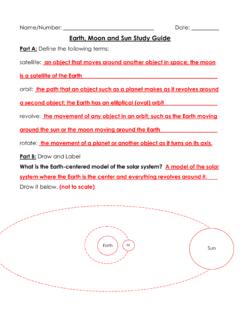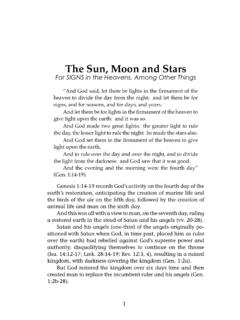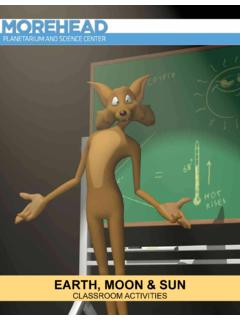Transcription of Orbit and Spin - New Horizons
1 Orbit and spin Overview: A whole-body activity that explores the relative sizes, distances, Orbit , and spin of the Sun, Earth, and moon . Target Grade Level: 3-5 Estimated Duration: 2 40-minute sessions Learning Goals: Students will be able compare the relative sizes of the Sun, moon , and Earth. contrast the distance between the moon and Earth to the distance between the Sun and Earth. differentiate between the motions of Orbit and spin . demonstrate the spins of the Earth and the moon , as well as the orbits of the Earth around the Sun, and the moon around the Earth. Standards Addressed: Benchmarks (AAAS, 1993) The Physical Setting, 4A: The Universe, 4B: The EarthNational Science Education Standards (NRC, 1996) Physical Science, Standard B: Position and motion of objects Earth and Space Science, Standard D: Objects in the sky, Changes in Earth and sky Table of Contents.
2 Background Page 1 Materials and Procedure 5 What I Science Journal Page 15 Earth Picture 16 Sun Picture 17 moon Picture 18 Earth spin Demonstration 19 moon Orbit Demonstration 20 Earth spin moon Orbit student pages 21 Extensions and Adaptations 24 Standards Addressed, detailed 25 Background: Sun The Sun is the center of our Solar System, as all of the planets Orbit around it.
3 Its rays warm our planet and sustain life as we know it. The Sun is very hot compared to temperatures we usually encounter. Its mean surface temperature is about 9980 Fahrenheit (5800 kelvins) and its interior temperature is as high as about 28 million F (15,500,000 kelvins). Some of that energy reaches Earth and keeps our surface temperatures relatively moderate; without the Sun our planet would be dark, icy and unable to sustain life as we know it. The Sun is by far the largest member of our Solar System and is a star. In fact, the Sun accounts for about 98% of the total mass of the Solar System. Even though the Sun is quite far away a mean distance of 149,598,000 km it is still a very prominent feature in our sky due to its large size. Earth Home! We know quite a bit about Earth and its oceans, landforms, people, biota, atmosphere, etc. So let s look at Earth from a different perspective and consider the aspects of the planet that are not so tangible.
4 Earth is the third planet from the Sun after Mercury and Venus. These planets, as well as the other planets, Orbit around the Sun. The American Heritage Dictionary defines Orbit as The path of a celestial body or an artificial satellite as it revolves around another body. Our year corresponds to one journey or one Orbit around the Sun for a travel time of days. If viewed from above our North Pole, Earth s Orbit around the Sun is in a counterclockwise direction (not to scale): Sun 1 While Earth orbits the Sun it also spins about its own axis. One day noon to noon, for example, or 24 hours corresponds to approximately one complete spin of Earth on its axis. The apparent motion of the Sun in the sky is due mainly to the fact that Earth is spinning. Earth spins in a counterclockwise direction if viewed from above the North Pole.
5 Notice that orbiting requires movement along a path, whereas spinning is around an axis within the body and could therefore happen without changing location. Of course Earth is both spinning and orbiting at once, so it is never spinning in place. (The following drawing is not to scale). Sun We have emphasized that these drawings are not to scale. Since the distance between the Sun and Earth is so large (150 million kilometers or 93 million miles) compared to the diameter of Earth (12,750 km), fitting a proper scale model of the Sun-Earth system on a regular sheet of paper would make Earth about 4/1000 of a centimeter too small to see! Put another way, if the image of Earth were 1 cm in diameter the image of the Sun would be 110 cm or feet in diameter and the distance between them would be 110 meters or 360 feet! moon The moon , with a diameter of 3,476 kilometers (2,160 miles), is significantly smaller than Earth, let alone the Sun.
6 Using the same scale model as in the Earth section above, note how this diameter relates to the diameters of the Earth and Sun. If Earth is 1 cm and the Sun is 110 cm, the moon would be 3 2mm in diameter. Using the same scale, the distance between the Earth and Sun would be 110 meters and the distance between the moon and Earth would be 30 cm. In summary, the moon is very small and very close to Earth compared to the Sun. The moon orbits Earth in a counterclockwise direction if viewed from above Earth s North Pole. It takes the moon about 27 days to complete a full Orbit . (Again, following diagram is not to scale!). Sun Interestingly, like Earth the moon also spins on its axis, and the time to complete one spin is the same as the time to complete one Orbit . That is, both the Orbit of the moon and the spin of the moon take about 27 days.
7 This means that the same side of the moon is always facing Earth, and likewise the far side of the moon never faces Earth. Like Earth, the moon spins in a counterclockwise direction if viewed from above Earth s North Pole. For clarity the Sun has been removed from the following image, but you can image it off the right side of the page and very large. 3 Unlike the other planets and their moons, we have walked on the surface of our moon . Neil Armstrong was the first person to step foot on the moon on July 20, 1969. He and other astronauts confirmed the moon s surface is heavily cratered from historical meteors impacts. These craters remain long after the meteor impacts due to the absence of an atmosphere or significant geologic activity. Now to put the Orbit of and spin of the Sun, Earth and moon together in one diagram, which is really, really not to scale: Sun Note: The Sun also spins on its axis in the same direction as the moon and Earth, but its spin is a bit more complicated.
8 The Sun spins faster at the equator than at higher latitudes, a phenomenon called differential rotation. Differential rotation is beyond the scope of this activity, but may be appropriate for students in later grades. 4 Materials: if possible, additional people (teacher s aide, volunteer, older students, parents, etc.) to help answer questions/guide learning at three stations on day 1 and two stations on day 2 copies of What I learned Science Journal page (5 per student) For the Earth, Sun and moon stations, you may wish to ask students to bring in objects that they feel represent these bodies Day 1 markers, crayons, or colored pencils copies of Fact Sheets (2 or 3 per station) o Sun: o moon : o Earth: a marble/1 cm diameter ball to represent Earth a piece of rice/3 mm item to represent the moon poster board to make 110 cm ( ft) representation of the Sun Earth station items (suggestions.)
9 Modify as necessary): cup of water (fresh and salt if desired) rocks plants/leaves balloon to represent air ball to represent spherical shape pictures to represent people/figurines a toy house to represent this is our home moon station items (suggestions; modify as necessary): rocks bowl of sand and marble students can make craters in the bowl by dropping the marble pictures of moon pictures of footprint on moon ( ; ) ball to represent shape (smaller than Earth ball if possible) Sun station items (suggestions; modify as necessary): large ball to represent shape light bulb to represent daylight pictures of Sun star shapes to represent the Sun is a star Day 2 ball firmly affixed to 2-3 foot string or paddle ball game (remove paddle) print out of Earth spin station demonstration page print out of moon Orbit station demonstration page 5 2 blank pages to assemble the Earth spin and moon Orbit station demonstrations scissors to cut out Earth and moon for the station demonstration pages 2 brads to affix Earth to Earth spin station demonstration and moon to moon Orbit station demonstration page (paperclips may also be used by bending the smaller part of the paperclip at a right angle to the larger part.
10 The larger part is parallel with the table while the small part goes through the holes in the pages, as indicated in the instructions for the station demonstrations). hole punch or a sharp pencil (brad is inserted through a hole hole must be round so moon can freely Orbit or Earth can freely spin ) copies of Earth spin and moon Orbit student pages (1 set per student, distribute to stations as indicated below) Orbit station items (suggestions; modify as necessary) moon Orbit station demonstration (assembled) Picture of a satellite around Earth Part of the Earth spin and moon Orbit student pages, as follows: o moon Orbit student page (classroom set) o Blank page with black circle in the middle (if desired, half of classroom set) o Brads or paperclips (half of classroom set) o Scissors (half of classroom set) o Hole punch or sharp pencil to punch holes (2 or 3) spin station items (suggestions.









